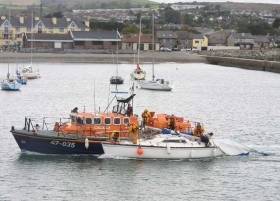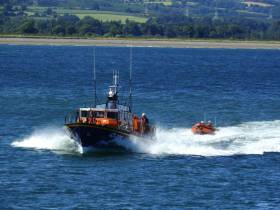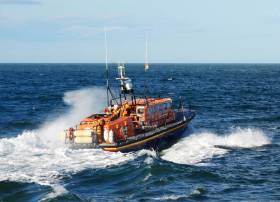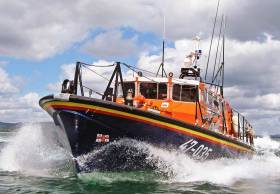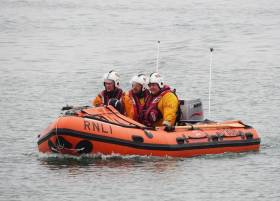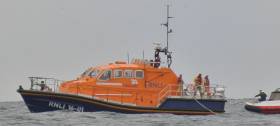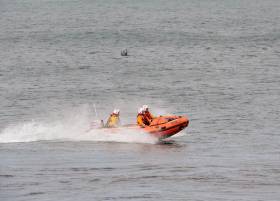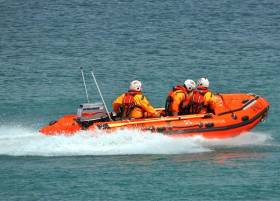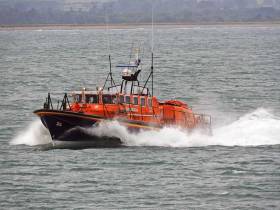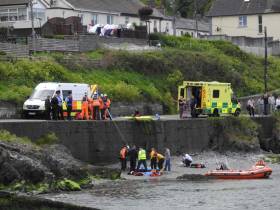Displaying items by tag: Wicklow
Wicklow Lifeboats Launch To Help Dismasted Yacht
#RNLI - Wicklow RNLI’s all-weather and inshore lifeboats launched yesterday afternoon (Sunday 1 October) after a 9m yacht with three people on board was reported to have lost its mast and rigging while racing in Wicklow Bay.
The all-weather lifeboat was alongside the dismasted yacht four minutes after launching at 3.30pm. Three lifeboat crew boarded the yacht and, as a precaution, two children were transferred from the stricken vessel onto the lifeboat.
Meanwhile, the inshore lifeboat crew were tasked with recovering the mast and sail from the sea, which were still connected by rigging to the yacht.
Once the mast and sail were recovered and secured, a tow line was established and the yacht was returned to Wicklow Harbour, where it was safely secured alongside the South Quay. Thankfully no one was injured during the incident.
Conditions at the scene had a westerly Force 3 wind with good visibility and a slight sea state.
The crew on this callout on the all-weather lifeboat were second coxswain Ciaran Doyle, mechanic Connie O'Gara, David O’Leary, Graham Fitzgerald, Vinny Mulvihill, Peter McCann, Joe Hanlon and John Stapleton. On the inshore lifeboat were helm Alan Goucher, Lisa O’Leary and Dean Mulvihill.
Wicklow Lifeboats Launch To Swimmer In Difficulty At Brittas Bay Beach
#RNLI - Both Wicklow RNLI lifeboats launched yesterday afternoon (Sunday 24 September) to assist a swimmer in difficulty at Brittas Bay.
The Dublin-based Irish Coast Guard rescue helicopter, the local coastguard shore unit and an ambulance crew were also tasked to the incident at the popular tourist beach.
The first report stated the man was swimming a short distance off the beach, but further reports stated he managed to get ashore.
The inshore lifeboat crew located the man at the South end of Brittas Beach, where they administered initial casualty care and first aid until he was handed over to paramedics.
Speaking after the callout, lifeboat press officer Tommy Dover said: “Thankfully the swimmer was okay after his ordeal and required no further medical attention after being assessed by the paramedics.”
The crew on the callout with the all-weather lifeboat were second coxswain Ciaran Doyle, mechanic Tommy Murphy, Tommy McAulay, David O’Leary, Lisa O’Leary, Kevin Rahill and Terry Sillery. Crew with the inshore lifeboat were helm Dean Mulvihill, Ian Thompson and John Stapleton.
Wicklow Lifeboat Tows Five On Damaged Yacht To Safety
#RNLI - Wicklow RNLI’s all-weather lifeboat launched shortly before 6pm on Saturday evening (9 September) to assist a 13m yacht in difficulties off the Wicklow coast.
The yacht was on passage from Wales to Ireland when the forestay snapped on its mast rigging, some 23 miles off Co Wicklow.
Unable to use their sails in case the mast broke, the yacht’s crew were also low on fuel, which would prevent them from reaching Wicklow Harbour under their own power, prompting the skipper to call the Irish Coast Guard by VHF radio for assistance.
The Wicklow lifeboat Annie Blaker, under the command of coxswain Nick Keogh and with six volunteer crew, was alongside the stricken vessel at 7.20pm. Conditions at the scene were described as sea state moderate, wind Force 5, westerly in direction with good visibility.
A towline was quickly rigged to the yacht and the lifeboat crew began a three-hour tow back towards Wicklow Harbour, where the vessel and its five sailors were brought safely alongside the south quay at 10.20pm.
The crew on this callout were coxswain Nick Keogh, mechanic Brendan Copeland, Ciaran Doyle, Lisa O’Leary, Terry Sillery, Paul Sillery and John Stapleton.
Wicklow Lifeboat In Search For Overdue Kayakers
#RNLI - Wicklow RNLI’s all-weather lifeboat launched at 8.37pm last night (Monday 28 August) to search for an overdue kayak.
The two kayakers on board were reported overdue to the Irish Coast Guard by a concerned relative after he lost mobile phone contact with them and darkness was falling.
Under the command of coxswain Nick Keogh, the lifeboat was on scene 10 minutes after launching and began a search off Wicklow Head, with the crew quickly locating the kayakers in fading light near the Horseshoe buoy.
The man and woman had earlier left the beach at Ballinacarrig, near Brittas Bay, heading north for Wicklow Harbour. But as they approached Wicklow Head, the tide and current was too strong and they were being pushed back in a southerly direction.
Rescue 116 was also tasked along with a coastguard shore unit from Wicklow. They were stood down once the casualties were located.
The two kayakers were transferred onto the lifeboat and landed safely back at Wicklow Harbour shortly after 9pm, where they were reunited with their relieved family.
Keogh was joined on this callout by mechanic Dean Mulvihill, Ciaran Doyle, Tommy McAulay, David O’Leary and Connie O’Gara.
Wicklow Lifeboat In Medevac For Injured Sailor
#RNLI - Wicklow RNLI’s inshore lifeboat launched yesterday afternoon (Sunday 20 August) to assist Wicklow Ambulance Service with the medevac of a sailor who sustained injuries while sailing in the bay.
The lifeboat crew, comprising helm David O’Leary, Graham Fitzgerald and John Stapleton, transferred the casualty from the yacht at the east pier to the nearby slip, where they were met by a waiting ambulance crew.
Fastnet Callout Sees Baltimore Lifeboat Bring Two To Safety
#RNLI - Two people watching the Fastnet Race fleet round the famous rock from a RIB yesterday (Tuesday 8 August) were rescued by Baltimore RNLI when their boat lost power.
The volunteer lifeboat crew, who were already on exercise in the area of Fastnet Rock, were alerted by a call from a nearby vessel at 3.15pm that another boat with two people onboard had lost the use of their engine.
The all-lifeboat was only two miles from the casualty vessel, a 7.5m RIB. Conditions at the time were good with a north-westerly Force 2-3 wind and a one-metre sea swell.
Once on scene, the lifeboat crew established a tow and brought the vessel back to Baltimore Harbour in West Cork, securing her to the pontoon before returning to the lifeboat station at 4.20pm.
Kate Callanan, Baltimore RNLI volunteer lifeboat press officer, commented: “Thankfully the lifeboat crew were on scene very quickly after the call was raised.
“Baltimore RNLI has a strong connection to the Fastnet Race having been involved in a number of dramatic rescues over the years. The lifeboat crew regularly exercise during the famous race to be nearby in case they receive a call for help.”
Elsewhere, Wicklow’s all-weather lifeboat launched at on Monday night (7 August) to assist two sailors on a yacht in difficulties about two miles north-east of Wicklow Harbour.
The eight-metre yacht was on passage south when it developed engine problems. The skipper contacted the Irish Coast Guard for assistance as they were unable to make any progress due to the lack of wind.
Under the command of second coxswain Ciaran Doyle, the lifeboat was alongside the casualty six minutes after launching. Conditions in the area had a calm sea state with light airs and good visibility.
A towline was quickly established and the yacht was brought back to Wicklow Harbour, where it was safely secured alongside the East Pier before midnight.
#Rescue - A mother and her two children were rescued from a sea cave at Silver Strand yesterday afternoon (Saturday 29 July) in a joint operation between Wicklow RNLI and the Irish Coast Guard.
The two children had got into difficulty while swimming at the popular beach south of Wicklow Head, and their mother rushed to their aid – only for the three of them to be swept into a nearby cave.
Wicklow RNLI’s inshore lifeboat was launched at 4.40pm and arrived on scene with the Dublin-based coastguard helicopter Rescue 116, which lowered a winchman onto the beach to locate the casualties.
The Wicklow lifeboat followed shortly after, and helm Graham Fitzgerald brought the rescue vessel close to shore where the lifeboat crew spotted three people and the winchman in a cave.
Weather conditions in the area were windy, with a southerly Force 4 and high breaking surf at the mouth of the cave.
After an assessment by the winchman and lifeboat helm, it was decided that the winchman would lead the casualties to the adjoining cave, as rocks at the entrance would impede getting the boat close to shore.
Once the casualties were in the other cave, the lifeboat crew brought the boat onto the beach and all three were transferred to the lifeboat along with the coastguard winchman.
The mother and her two daughters were believed to have been on a day trip to the beach when they decided to go for a swim and one of them got into difficultly. Her sister had tried to help, but also got into trouble.
The mother then entered the water to help her daughters, which resulted in all three of them ending up in the cave.
The winchman, a trained paramedic, assessed the three casualties on the lifeboat and they were brought to Wicklow Harbour, where they were given hot drinks.
Wicklow RNLI were involved in a similar rescue at Silver Stand in 2014 when the lifeboat was called out to rescue a woman who had been swept into a cave after getting into difficulty swimming.
#RNLI - Wicklow RNLI’s inshore lifeboat was launched at 1.48pm on Saturday afternoon (24 June) after a member of the public reported a windsurfer in difficulty off Silver Strand, three miles south of Wicklow Harbour.
The lifeboat with three crew — helm Graham Fitzgerald, Vinne Mulvilhill and Connie O’Gara — was alongside the casualty seven minutes after launching. A local angling boat had also stood by the windsurfer until the lifeboat arrived.
The casualty was taken onto the lifeboat and assessed. He did not require any medical assistance and was landed safely back on Silver Strand a short time later.
Speaking after the callout, Wicklow RNLI lifeboat helm Graham Fitzgerald said: “We located the windsurfer about half a mile offshore. He had left the beach earlier but the wind dropped and he was unable to get back ashore.”
Wicklow Lifeboat Assists Whelk Fishing Vessel
#RNLI - Wicklow RNLI's all-weather lifeboat launched at 2.50pm yesterday afternoon (Wednesday 14 June) to assist the crew of a whelk fishing vessel off the Wicklow coast.
The skipper contacted Wicklow Head Coast Guard by VHF radio for assistance after a rope got caught in the trawler’s propeller.
The lifeboat, under the command of senior deputy second coxswain Tom McAulay and a volunteer crew, was alongside the casualty 40 minutes after launching at a point over 12 miles north of Wicklow Port near the Codling Bank.
While the lifeboat was en route, the three fishermen reported that they managed to clear the rope from the propeller and were able to get underway.
McAulay carried out an assessment and the lifeboat escorted the trawler while it crossed the Codling Bank.
Once satisfied that the obstruction was clear and the fishing vessel was capable of resuming its passage safely back to Wicklow Harbour, the lifeboat returned to station.
The crew on the call out were McAuley, mechanic Brendan Copeland, Terry Sillery, Carol Flahive, Lisa O’Leary, Paul Sillery and Dean Mulvihill.
#RNLI - Wicklow RNLI lifeboat pagers were activated at 12.24pm on Tuesday afternoon (16 May) after a cyclist had fallen from the quayside onto the Strand beach at Wicklow Harbour.
The volunteer inshore lifeboat crew were on scene within minutes and were met by ambulance personnel on the beach, who were assessing the casualty,
Due to the difficult rocky terrain of the beach and the rising tide, the lifeboat crew prepared a stretcher to transport the casualty by boat to the nearby slip.
With the arrival of an Irish Coast Guard cliff rescue unit, it was decided instead to use their specialist climbing equipment to winch the casualty off the beach by stretcher.
Many of the lifeboat crew had also assembled at the Strand and began to assist with the stretcher extraction.
The casualty was lifted from the beach up onto the road, and brought to hospital by a waiting ambulance.
“Our volunteer crew would like to wish the man a speedy recovery from his fall,” said lifeboat press officer Tommy Dover, adding: “This was also the first call out for our new inshore lifeboat Dennis-Audrey, which was officially named earlier this month.”


























